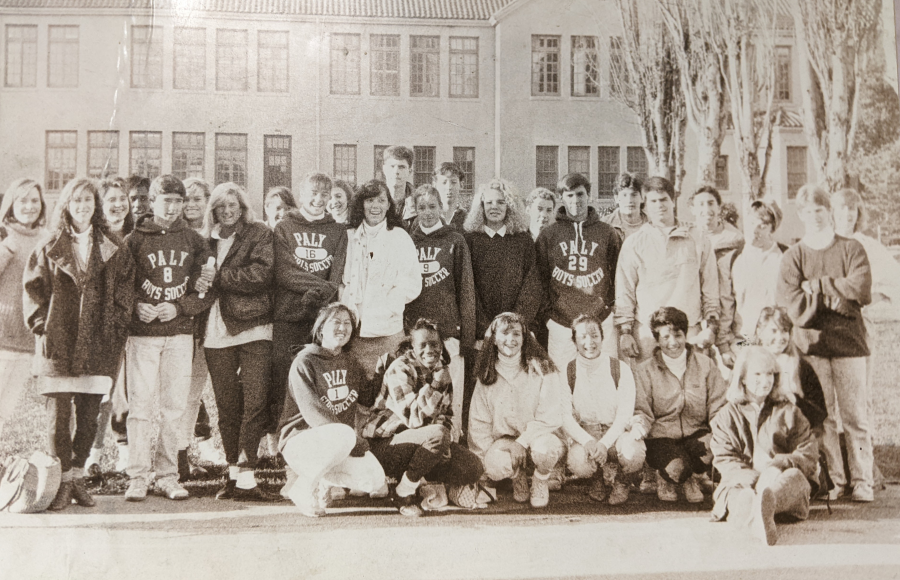Math Instructional Leader Natalie Docktor stands in front of the wooden desk in her office, holding a black and white photo that shows 12 students standing in front of a blackboard in a small classroom, facing the camera.
“This was my Analysis class in 1989,” Docktor said. “Look how little (the class was). I took them all skiing. One of the kids in the class had a cabin, and so we all went skiing together, and that was pretty special.”
Docktor joined the math department 34 years ago in 1988. One of Paly’s longest tenured teachers, she has seen the school evolve physically, academically and culturally through the past 34 years.
For one, she said the student body and faculty have grown immensely in number.
“When I came here, we had about 1,100 students,” Docktor said. “It was small. The math department was nine of us. We knew everybody in the school, and I loved it.”
With a smaller staff, teachers connected with their colleagues on a more personal level, Docktor said.
“We used to have staff get-togethers and more parties, so the whole staff knew each other better back in the day. But then we’ve grown, and we’ve got over 2,000 students now. The departments have always been different, but it’s harder to get them together. The unity in a sense has really changed.”
To accommodate more students, Paly’s campus has also changed dramatically. U.S. History teacher Steve Foug has been at Paly since 1999 and said much of the old campus has been remodeled.
“There used to be a long science building, kind of a nondescript building,” Foug said. “Where the soccer field is and part of where the new science building is, there used to be a big long amphitheater. That’s where a lot of the spirit week rallies were.”
Foug said it can be easy to forget that much of Paly’s campus is newly constructed.
“The MAC and the PAC are brand new, and of course the gym is,” Foug said. “These updates and new things are dramatic changes that have happened in the past 20 years.”
Another major part of change at Paly has been the introduction of new technology into the classroom. Foug said technology has enabled new ways to teach students and made teaching more convenient.
“The number of things I have access to is remarkable,” Foug said. “I used to have to go home, put in a VCR tape to tape the news every night, watch it on the tape, and bring the tape (to class). Now I just click on YouTube and find the news clips which is incredibly convenient.”
However, Foug said smartphones have been disruptive to learning in the classroom.
“In my class rules, I say please, no phones. Keep them away and turned off, but it’s like playing Whack-A-Mole with that. It drives me nuts,” he said. “I always notice it, and it bothers me. I would say that aspect of technology has been an irritant.”
Aside from physical and technological changes, the school has seen generations of students with different backgrounds walk through its halls.
History teacher Katya Villalobos, who has also been an administrator and started in the district 23 years ago, said students today are more socially aware than they used to be.
“Students are more open to things and sharing things that they wouldn’t have necessarily shared,” Villalobos said. “For example, the conversations we have now about mental health. It’s not that we weren’t talking about mental health before, but in terms of the culture of the school, we definitely are more (willing) now. Students are more willing to discuss it, and even more positive, students will share when they’re worried about their friends and talk to us.”
Socially, Foug said while student stress about academics and college have always been prevalent, student anxiety has grown worse over the last two decades.
“Stress has always been an issue here,” Foug said. “I think that was true 20 years ago. That is now probably more so. I’d say academically things seem more intense like the number of APs kids seem to take. That seems to be a product of how the admissions game goes, so it’s unfortunate when students get sucked into that.”
Despite all the drastic changes at Paly, Docktor said students have always been intellectually curious and fun to work with.
“The students have so much potential, and that’s why I think teachers stay here, because the students are so wonderful. I’ve always valued the students, and I think it’s a good place to be. I still love my job after all these years, and I still like working with young people.”
Docktor said Paly has always maintained a staff of amazing teachers that she has formed bonds with over her career.
“It has been fabulous to grow up with all of them,” Docktor said. “We all got married. We all had kids, and we all went through life together. That’s a rare thing that happens in this day and age, that you stay with a group of people and go through your whole career.”

